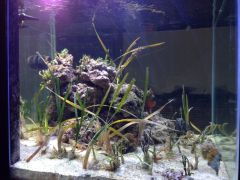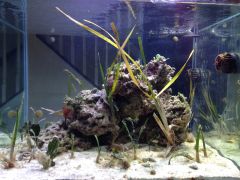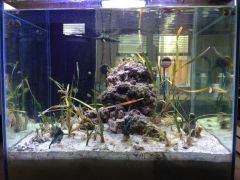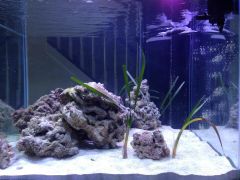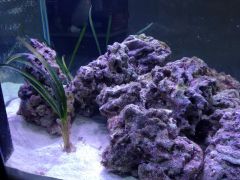
braden
BB Participant-
Posts
36 -
Joined
-
Last visited
Content Type
Profiles
Forums
Gallery
Events
Store
Everything posted by braden
-
The water is cloudy and definitely brownish. Not dosing anything. There is a small amount of macroalgae on the rocks; but it's really just a few bits here and there. I'm sure nothing got dumped into the tank. As for stray voltage... maybe, but unlikely. I certainly don't feel anything when my hand is in the tank. I think the only potential source is the heater, which is only a month or two old. Could it potentially be an algal toxin? I'm wondering if that algae on the glass might have gone sexual and released some toxin into the water in the process. Yeah, I'm grasping at straws, here.
-
As I said, the tank was fine yesterday. As far as water parameters, it's probably been a while. I tend not to check as long as things are looking fine. The filefish was last seen alive around midday yesterday. I did not check the tank yesterday evening. When I retrieved his body this morning, there was no visually apparent decomposition. As of today, nitrate is also undetectable. The algae looks like it's taken a hit, too. It's light brown stuff... kinda slimy; but it's not just a film. It grows in feathery wisps if allowed to (and I had, a bit). It only grows on the glass; not the rocks. But it looks like it's lost some of its color since yesterday. Temperature is around 79°F. Salinity is around 32‰. No cleaners have been used around the tank. (BTW, probably closer to 35 or so lbs of rock in there now. I forgot that I removed some after the initial cycle.)
-
Toward the end of last summer, I set up a 30-gallon tank with about 50 lbs of high-quality Indonesian live rock. I let the tank cycle by itself for many months, adding the first fish, a 2" matted filefish, about a month ago. The tank just has a hang-on skimmer (JNS VS1); but I planned on keeping the bioload low. The filefish seemed to be doing fine. As of yesterday, the water was clear and things appeared normal. Quite a bit of algae on the front glass I'd neglected to clean; but otherwise just fine. This morning, I awoke to the skimmer going crazy, overflowing with wet skimmate. The water is cloudy and slightly brownish. The filefish is dead. So, I test for ammonia. It's not detectable. Now, I'm scratching my head as I do water changes. What happened here?
-
Popular size, indeed; I'm using one of those for my seagrass bed aquarium. I opted just to paint the overflow area on mine, as mine has some visibility even from the back. (It's at one end of a kitchen island.) I do love the visibility in these tanks and the rimless look; though the stand can be a bit inconvenient to work in. You have any particular plans for this tank?
-
I see them not infrequently at the Manassas Petco.
-
...and, yes, they're practically impossible to pry off. You'd probably seriously injure it (and possibly yourself) in the process.
-
Nah, you got a chiton! Lucky you! It's an herbivorous mollusc; eats about the same stuff as an abalone.
-
CaribSea has a number of different sands. I've used their OceanDirect Bahamas oolite (which you're not supposed to rinse); and it ends up looking very light gray under metal halide lights. The oolites tend to appear in pictures as their lightest-colored sands. For the most recent tank I put together, I used Nature's Ocean Indonesian Reef sand. It's not white; it has a bit of a brown/yellowish cast to it. Looks nice, though. It took a lot of rinsing. The last water I poured off of it was still somewhat cloudy; but after running a skimmer on the tank for a few days, it cleared up nicely. Nature's Ocean does have a Marine White Sand that might be closer to what you have in mind.
-
Kessil a160we and spectral controller setup help
braden replied to nextlevel808's topic in General Discussion
I don't have one yet; but, after researching these, I found that I'd need an A360W or two A160Ws for a 30-gallon tank. So, I tend to agree with @khh27 that this doesn't sound like nearly enough light. Kessil has a chart that provides some guidelines on their Getting Started page. As far as help with the tuning, I found Kessil support to be very responsive; you might want to give them a try. -
There's a Molly Miller blenny in there and five peppermint shrimp, along with two largish red brittle stars and a fair number of snails (Astrea, cerith, Nerite) and blue-legged hermit crabs. I feed the tank about twice a week. Turtle grass actually thrives in a relatively low-nutrient environment where it's able to out-compete most algae for nutrients. Much of the grass in this tank came from the tank of another member who decided to take his tank in a different direction. It had basically taken over in his reef tank. I'm still trying to get the nutrient balance in my tank right; and part of that will come as the grass establishes itself a bit better. I continue to have problems with nuisance algae. Too few nutrients are not my current problem. I don't want to add horses (or much else that's not going to consume detritus or nuisance algae) until I feel like I have a good handle on this. I had some Caulerpa mexicana in the tank for a little while; but I pulled it all out after it started to take over the tank.
-
I'm sorry you're having such a bad time of it. I'm going to make a few general comments that you might want to consider as you approach this hobby moving forward. Always consider Murphy's Law. Now, we cannot realistically account for every failure mode. If a faulty tank fails, we're pretty much screwed. But aside from that, always consider the potential failure modes for a setup and account for them to mitigate damage. Make pessimistic assessments. If the likelihood of failure is too high and the potential damage too great, it might be best to find another place for the tank. If you don't have a reliable partner in this endeavor, be self reliant. Fix the ATO yourself, etc. Get your house fixed. You don't need the reminder of that disaster. I know I'm sounding preachy at this point, but I have some personal experience in this regard.
-
Yes, you could certainly run a light-to-moderate bioload with good circulation within the tank and a hang-on skimmer. There's nothing especially magical about a sump. It increases your water volume a bit, gives you more options for skimmers, and usually makes ATO a little easier; but beyond that, it's mostly a convenient place to hide stuff. Having a sump does usually come with surface skimming. That's important; but there are other ways to get it. Some HOB skimmers have intakes that do surface water extraction.
-
A trickle filter can generate nitrates if it clogs with detritus. If it doesn't clog with detritus easily, it probably doesn't have that much surface area for nitrifying bacteria to colonize. At the very least, there are better things that you could be doing with that space in your sump. Your skimmer can go anywhere in the sump that it will fit. If you are worried about noise, I have my drain pipe submerged in my sump. It's pretty quiet aside from the occasional large bubble. Some people use filter socks over the drain pipe (which will also reduce noise); but you must change/clean them frequently. They aren't at all plankton-friendly (which is why I don't use them); but that probably doesn't matter in your fish-only tank.
-
If you have a reasonable amount of live rock, good water circulation, and a reasonable amount of light, the (biological) filtration capacity added by a wet/dry filter is negligible. A good protein skimmer and a refugium will be much more effective components of your filtration scheme.
-
Recall that denitrifying bacteria (the ones that process nitrate) are anaerobic. It is likely that the process of transferring the sand exposed them to too much oxygen and substantially reduced their population. At the same time, that old sand may have included detritus that had previously been trapped in the sand bed; and moving the sand stirred it up. I wouldn't worry too much. The denitrifying bacteria will reestablish themselves; just give them time.
-
If its shell was more-or-less cemented to the rock it was an oyster. If it was attached less permanently, it was attached with byssal threads and it was a mussel or related bivalve. (Flame scallops will attach themselves with byssal threads, too.) Generally, these bivalves are good for your tank. If they're not in a spot you like, they can be relocated safely (if they aren't oysters).
-
Looks like an oyster to me; but could be a mussel or similar bivalve. If it were a barnacle, you'd see filter-feeding legs come out and rake through the water at some point.
-
93-gallon Caribbean seagrass/mangrove biotope
Images added to a gallery album owned by braden in Member's Gallery
-
From the album: 93-gallon Caribbean seagrass/mangrove biotope
© Braden McDaniel
-
From the album: 93-gallon Caribbean seagrass/mangrove biotope
© Braden McDaniel
-
From the album: 93-gallon Caribbean seagrass/mangrove biotope
© Braden McDaniel
-
I went for the Compact +5000 on my 93-gallon (probably ~4ft head), with the knowledge that I'd probably need to dial it back a bit. (The Compact + pumps have an adjustment valve for the output.) I figured that I'd rather have a little power to spare than regret not having a little more. No regrets. And, in fact, I've got it running at nearly full blast.
-
This is bogus. Cyanobacteria are bacteria; and while they might have cellular appendages like cilia or flagella (not even sure about the latter), the complexity and extent of their macrostructure will be very limited. They are photosynthetic bacteria and they need light to grow; they won't be buried anywhere they can't get light. The red that you see is the chlorophyll inside the bacteria; not some byproduct. Vacuuming it up, of course, is no guarantee you'll get every last trace. In fact, you should abandon any hope of removing every last trace of it. Vacuuming it up accomplishes removal from your system of the nutrients contained within the bacteria (and within the detritus that the bacteria are growing on). The problem that ultimately needs solving is an excess of nutrients. Note that such excess might not necessarily pervade the system, but be localized to the surfaces where the bacteria are growing.
-
Well, yeah. A Ca(OH)2 suspension is not much of a buffering agent; it's just a moderately strong base. You shouldn't add it with the goal of raising pH; that effect is mostly ephemeral. (Temporarily) raising pH is a side-effect of what it offers; one that is generally counteracted by slow addition. Slightly high, but not worrisome. It's probably dropped down quite a bit by the time you read this. No. Unless your bioload is really heavy, don't worry. As long as water's circulating well, there will be plenty of oxygen. If what you mean is "How long should I wait before pumping this water with a really high pH into my tank?" the answer is that you should wait until the pH isn't very high anymore. Bubble CO2 in your sump. The Ca(OH)2 will precipitate out as CaCO3 and the pH will right itself. Dilution is another valid approach to solving the problem. In the future, use a buffering agent to raise your pH. These will raise the pH slightly and gradually and keep it at a proper level.
-
High nitrates in my biocube29? Maybe not sure
braden replied to Jhead85's topic in General Discussion
It'd be nice to get another reading on your water quality; perhaps take it into a store to get it tested. Had the anemone been eating well prior to its decline?


